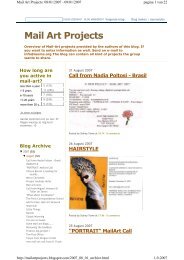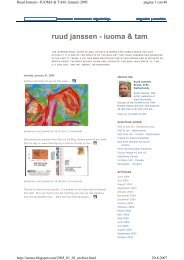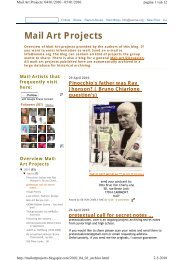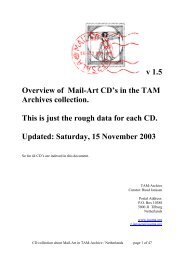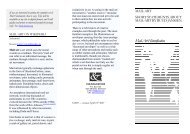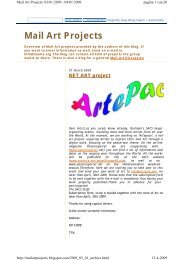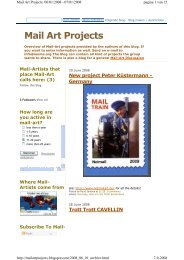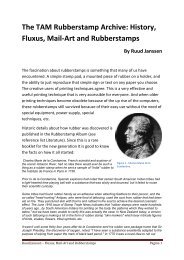Network Atlas by Geza Perneczky - Ruud Janssen
Network Atlas by Geza Perneczky - Ruud Janssen
Network Atlas by Geza Perneczky - Ruud Janssen
Create successful ePaper yourself
Turn your PDF publications into a flip-book with our unique Google optimized e-Paper software.
344materials, I mean a particular issue was a page of hand made paper, made of theseart pieces with a list of them typed on. The size of the edition was depending onnumber of ingredients, a copy being mailed to each „participant“ later...» (Editor'sstatement in Artforum #7, 1981)«N° 1 of Commonpress is dated December 1977 and perhaps this is the true timeof its appearence. I don't remember when I did start the idea, remembering aboutthe fact that the very first invitations (as well as the first issue itself) were printedillegally, the whole matter must have been slow. So I suppose a full year wasnecessary to do...» (From a letter to Géza → <strong>Perneczky</strong>, Feb. 2, 1988)Géza <strong>Perneczky</strong>: The Magazine <strong>Network</strong>. The trends of alternative art in the lightof their periodicals 1968-1988. Edition Soft Geometry. Köln, 1993. 14-16, 74, 87,(Commonpress:) 125-126 p.«...Mail Art was never respected <strong>by</strong> the official artists and art critics of Poland.The number of mail artists were always small, fewer than twenty, and primarilyincluded H. Bzdok, T. Schulz, A. Dudek-Dürer, R. Rupocinski, A. Kriko, W. Ropiecki,and P. Rogalski. (Note: Wisniewski, Przyjemski, Kulik, Kwiek and Partumwere Polish artists whose activities involved some mailing strategies, but whichwere never designated <strong>by</strong> each artistas „mail art“... I have a catalogue for a Polishmail art show organized in 1974 <strong>by</strong> ... Klaus → Groh. The small, gallery mail artshow was entitled, The Exhibition of the INFO Group.) (Look at → Kozlowski /Kostolowski for more data of the early Mail Art like activities in Poland – note <strong>by</strong>the editor of this <strong>Network</strong> <strong>Atlas</strong>.) The mail art network was useful, however, as oneof many information holes punched through the Iron Curtain. Mail art itselfprobably had little effect in breaking down Communist oppression. In a largersense, however, mail art helped to free Polish artists from a feeling of rejection<strong>by</strong> others on the world...»(Pavel Petasz: Mailed Art in Poland. In: Chuck → Welch [ed.]: Eternal<strong>Network</strong>. A Mail Art Anthology. University of Calgary Press, 1995. 89-93 p.)«Perhaps the most well known communal mail art publishing effort is the Commonpressproject initiated <strong>by</strong> Polish artist Pawel Petasz in December 1977. The conceptstarted small with Commonpress #1 attracting seventeen contributors. There was notheme for the first issue other than the title Commonpress.The originality of the concept is that instead of editing the second number,Petasz assigned different editions to different people who created, produced, anddistributed the issues on different themes.In his introduction Petasz states that, „Commonpress is a magazine editedirregulary <strong>by</strong> the persons interested in publishing materials themselves... A will toedit an issue ought to be submitted to the coordinator and hence harmonized withthe sequence and timing... A particular editor of an issue ought to produce invitationsor other details of theme, size, technical qualifications, deadline and hisaddress... Each issue is edited, printed and distributed at the particular editor'sexpense. He cannot charge the participants...“Some sixty issues of Commonpress were issued between 1977-85. Thesewere documented <strong>by</strong> Guy Bleus in Commonpress #56... Petasz passed the organizationof Commonpress on to Canadian Gerald X. → Jupitter-Larsen when conditionsof political oppression worsened in Poland. Larsen wrote that, „Commonpressisn't just an alternative magazine of art, but a kind of ongoing internationalperformance. A performance in which each participant is encouraged to edit andpublish an edition of the magazine with his own theme in his own format. It is acollective performance; created, produced, and shared <strong>by</strong> its many contributors.“However, despite his best intentions, Jupitter-Larsen, best known, for his„non-pereformances,“ turned Commonpress into a vehicle of „non-publication“ andthe publication came shortly to an end.»



